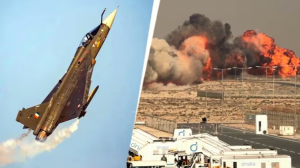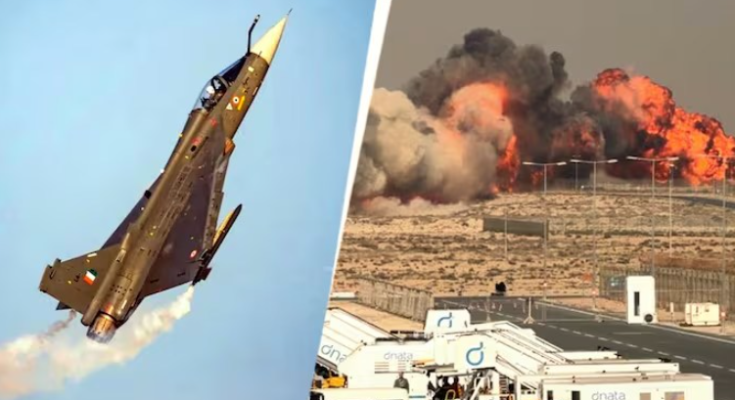
What Happened: The Crash
On November 21, 2025, during the final day of the Dubai Air Show, an Indian Air Force (IAF) HAL Tejas fighter jet crashed while performing a demonstration flight at Al Maktoum International Airport in Dubai. www.ndtv.com+3Al Jazeera+3India Today+3
Eyewitnesses report that the aircraft, flying at a low altitude in front of spectators, lost control mid-maneuver. Gulf News+2India Today+2 Videos circulated on social media show the jet suddenly descending before diving toward the ground in a steep nose-dive, erupting into a fireball on impact. www.ndtv.com+1 A large, thick plume of black smoke rose from the crash site, prompting gasps from onlookers. The Indian Express+2Business Today+2
The IAF confirmed that the pilot was fatally injured. www.ndtv.com+1 The Indian Air Force released a statement saying:
“An IAF Tejas aircraft met with an accident during an aerial display … The pilot sustained fatal injuries … A court of inquiry is being constituted, to ascertain the cause of the accident.” www.ndtv.com+1
Emergency and firefighting teams responded quickly, working to extinguish the blaze and secure the area. Gulf News+1 The show was briefly suspended, though later in the afternoon, flight demonstrations resumed. The Economic Times+1
Who the Pilot Was
The pilot has been identified as Wing Commander Namansh Syal, aged 37, from Himachal Pradesh, India. The Times of India+1 He was a seasoned IAF officer; reports indicate he may not have been able to eject before the crash. www.ndtv.com+2Gulf News+2 Indian authorities expressed deep sorrow, offering condolences to his family. Hindustan Times+1
Technical Details & Possible Cause
-
The aircraft involved was a Tejas Mark-1, a light combat aircraft developed by India’s Hindustan Aeronautics Limited (HAL). India Today+1
-
According to some reports, the jet failed to recover from what’s described as a “negative G-turn”, a maneuver that can be especially challenging at low altitude if energy or control is mismanaged. www.ndtv.com+1
-
Observers and defense analysts are cautious: at this stage, the exact cause of the crash is not established. The Economic Times+1
-
A court of inquiry (CoI) has been constituted by the IAF, and they are coordinating with UAE authorities. www.ndtv.com
-
Investigators will likely examine multiple factors: mechanical failure, engine issues, flight control systems, pilot response, and maneuver risk. The Economic Times
Broader Context: Why This Matters
-
Tejas Program Significance
-
The Tejas aircraft is a critical part of India’s push toward defense self-reliance. India Today
-
India’s government recently signed a major deal for 97 additional Tejas jets. AP News+1
-
This crash is a high-profile setback, especially since the Tejas is being showcased internationally (like at the Dubai Air Show) to boost export potential. India Today
-
-
Safety and Reputation
-
This incident marks the second known Tejas crash: the first was in March 2024 in Rajasthan, from which the pilot ejected safely. www.ndtv.com+1
-
Public and investor confidence could be shaken. A crash during a demo flight, especially in front of international audiences, raises concerns about reliability and safety.
-
-
Strategic Implications
-
For India, the Tejas is not just a national pride project but also a strategic asset. Its success could help modernize the IAF’s fleet, which still includes many older Soviet-era aircraft. Al Jazeera
-
A crash like this could complicate export deals or delay deliveries, possibly affecting India’s defense modernization timelines.
-
-
Diplomatic Dimension
-
The crash happened on foreign soil (UAE), involving cross-national cooperation in the investigation. This introduces diplomatic sensitivities — India needs to navigate the inquiry while maintaining good relations with the UAE.
-
The fact that the air show was a global event with manufacturers, militaries, and governments watching increases the scrutiny.
-
Reactions & Aftermath
-
IAF and Indian Government: The IAF publicly expressed deep regret and promised a full investigation. The Times of India India’s Defense Minister, Rajnath Singh, also expressed his condolences, calling the loss “deeply anguishing.” Hindustan Times
-
UAE Response: The UAE Ministry of Defence confirmed the crash, said that emergency teams responded rapidly, and that the site is under control. The Indian Express+1
-
Public Reaction: Spectators at the air show reportedly panicked. Videos on social media show gasps, people backing away, and a dramatic fireball. The Indian Express
-
Media and Analysts: Many commentators are weighing in on the possible causes — from pilot error during high-risk maneuvers to potential technical failures.
Risks Highlighted by This Incident
-
Aerobatic Demonstrations Are Inherently Risky: Airshow flying, especially with combat aircraft, pushes machines (and pilots) to their limits. Even highly trained pilots can face unforgiving dynamics.
-
Low Altitude Maneuvers: When jets perform at low altitude, there’s very little room for error. If a maneuver goes wrong, recovery time is minimal.
-
Export and Reputation Risk: A crash at a global airshow could undermine marketing efforts. Tejas is pitched to potential buyers; such an incident could raise doubts.
-
Program Risk: Any crash triggers deeper scrutiny of design, maintenance, supply chain, and training. If a systemic issue is found, it could delay further production or deliveries.
-
Pilot Safety: It also underlines the very real personal risk to the pilots — in this case, tragically, a life was lost.
Lessons & Potential Next Steps
-
Thorough Investigation: The court of inquiry must be rigorous. Recovery of the black box/Mission Data Recorder will be crucial. Analysts will want to know exactly what failed (or what went wrong in pilot decision-making).
-
Review Demonstration Protocols: The IAF and HAL might reconsider which maneuvers are flown during public displays, especially high-risk ones.
-
Training and Safety Improvements: Depending on the investigation outcome, there may be changes to pilot training, especially for demonstration flying.
-
Communications Strategy: India likely needs a strong messaging campaign to reassure both domestic and international stakeholders (military, political, and commercial) about the safety and future of the Tejas program.
-
Design & Engineering Reassessment: If a technical flaw is identified, HAL / ADA (Aeronautical Development Agency) may need to make design tweaks, or operational limits could be revised.
Bigger Picture
-
The Dubai Air Show is one of the world’s premier aviation events — companies and countries use it to showcase cutting-edge technology and build export opportunities.
-
That a home-grown fighter like the Tejas crashed in such a high-profile setting is symbolically significant: it’s a reminder that building advanced military tech is inherently risky, but also that failures can carry outsized reputational costs.
-
For India, this crash is not simply a tragic accident — it’s a challenge to its ambition of becoming a major defense exporter and self-reliant in aerospace.
Conclusion
The Tejas crash at the Dubai Air Show is a deeply tragic and consequential event. A talented Wing Commander, Namansh Syal, lost his life, and questions now swirl around what precisely caused the aircraft to dive out of control. For India, the stakes are high: Tejas is a symbol of national capability, but also a critical piece of future defense and export strategy.
The investigation ahead will be closely watched — not just in India, but internationally. Depending on its outcome, the Tejas program could face serious scrutiny or, with reforms, emerge stronger. Regardless, the crash underscores the inherent dangers of fighter aviation, especially in the glare of the global stage.

